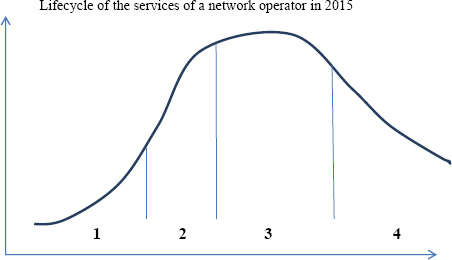Appendix 10
NGN and the Internet in Figures
In 30 years, the Internet has conquered over half the globe and the NGN standards which connect fixed-line networks to mobile networks have shown the consistency of the plans initialized several decades earlier. These positive results demonstrate the merits of the proposals made internationally on the political and commercial levels.
Connections
New generation networks (NGNs) ensure the inter functionality of digital circuit-switched telephone networks with digital mobile telephone networks and the Internet. Internet access through a digital circuit-switched telephone network requires the use of compatible dial-up modems or connection through a suitable digital link (ADSL, VDSL2). No mobile telephone terminals consistently provide access to all multimedia applications available on the Internet. A broadband Internet connection is a guarantee of good quality of service for multimedia applications.
The Internet’s place in the world at the end of 2015
At the end of 2015, the number of subscribers in mobile cellular telephony surpassed 7 billion (usage rate of 97%) and 9.5 billion mobile subscriptions are expected by the end of 2020. Between 2000 and 2015, global Internet penetration rose from 6.5 to 43%, a sevenfold increase. Fixed broadband technology is spreading at a slower rate and reached 11% penetration by the end of 2015. Mobile broadband is the most dynamic part of the market worldwide and had a penetration rate of 47% at the end of 2015, 12 times the 2007 figure. The proportion of households with Internet access has risen from 18% in 2005 to 46% in 2015.
The number of Internet users worldwide has more than tripled in 10 years, increasing from a billion in 2005 to 3.2 billion at the end of 2015, of whom 2 billion have access through a mobile telephone. However, “the effects of this technology on global productivity and improving opportunities for the poor and the middle class have not lived up to expectations”, according to a report by the World Bank, which highlights some negative effects on the labor market.
Almost 4.2 billion people, close to 60% of the world’s population, still do not have access to the Internet. Broadband Internet only serves 1.1 billion people, or less than 15% of the worldwide population. India has the highest number of people without Internet connections (1.1 billion), followed by China (755 million) and Indonesia (213 million).
Internet penetration is assessed according to the “proportion of the population, which has the opportunity to access this network using a computer, mobile telephone, personal digital assistant, games consoles, television sets” and so on. In 2014, the statistics prepared by the World Bank show that while the level of Internet penetration per 100 inhabitants is very high in Finland and Denmark (96%), it remains very low (between 1.38 and 4.8%) in sub-Saharan Africa (Benin, Ethiopia, Democratic Republic of the Congo, Tanzania). At the end of 2015, China recorded 600 million Internet users (httpp://data.un.org/).
In OECD countries, eight adults in 10 are connected to the Internet. Approximately half of Internet users visit social networks and purchase goods and services online. Currently, 41% of Internet users connect through a mobile telephone or smartphone. In terms of usage, six Internet users in ten visit social networks and 50% purchase goods and services online. Merely one-third of users have recourse to electronic administration services and only one in 10 makes medical appointments on the Internet. Furthermore, in 2012, small businesses were almost all connected in Canada, Denmark, Finland, France, Iceland, South Korea and Switzerland, and only 21% of them offered products for sale online.
In Europe
In 2014, almost 75% of subscribers in the European Union received broadband. The average speed increased from 30 Mbps in 2013 to 38 Mbps in 2014. The European Commission is proposing to increase the number of broadband connections (at least on a par with 30 Mbps) in rural areas of Europe through the proliferation of long-term loans. The European Union performs better than the United States in terms of Internet access speeds. ADSL technologies provide speeds of 8.27 Mbps in Europe and 7.67 Mbps in the United States, with cable delivering 66.57 Mbps in France and 25.48 Mbps in the United States and fiber 53.09 Mbps in France and 41.35 Mbps in the United States.

Figure A10.1. Decrease in telephony costs (in SDR) between 1988 and 2008 (Source ITU-T)
Almost 95% of residents and businesses in the English region of Cornwall will soon have access to a very high speed fixed-line Internet connection. The major advantages that this technology brings are related to being able to put videos and other content online more quickly, the opportunity to work from home, making conference calls without interruption or even international communications using VoIP. The British want to make Cornwall a European Silicon Valley, an ambitious program for this region of 500,000 inhabitants, which should welcome a cluster linked to the universities of Falmouth and Plymouth.
Broadband prices went down by 12% in the European Union between 2012 and 2015, and by almost 20% for speeds ranging from 30 to 100 Mbps. The disparities between European countries can be large. Over 99.4% of European homes had access to at least one fixed or mobile broadband technology in 2014, according to a study carried out by the European Commission.
In France
According to Arcep’s annual survey, in 2015, 58% of the French population had a smartphone and 8% of French people still had no mobile telephone. In spite of this, the use of mobile telephone equipment (92%) still surpasses fixed-line equipment (89%). In 1 year, the average consumption by 3G and 4G subscribers almost doubled to reach 1.1 Gbps. Because of 4G, Orange’s mobile subscriber base passed the 24 million mark (+10%), in which the number of customers has reached 8 million. With regard to fixed line, very high speed broadband is making progress: it increased from 9 to 14% of connections in homes. Fiber-optic connection, on the other hand, has barely taken off (4% against 3% in 2014). The French are coming around to social networks a little more each year: in 2015, 62% of them were registered on Facebook, Twitter or LinkedIn.
Orange set a target of 12 million connectable French households in 2018 and 20 million by 2022. At the end of 2015, Orange had a total of almost 1.9 million customers in fiber-optics and almost 13 million homes connectable by fiber-optics. In the French business market, Orange is continuing with development of Fiber To The Office (FTTO) with over 31,000 connected customer sites to date.

Figure A10.2. Lifecycle of services in 2015: 1) Introduction – Internet of hings – Mobile financial transactions – 5G; 2) Developments – Broadband – Fiber-optic; 3) Maturity – DSL – 3 and 4G; 4) Decline – RTC – Gigabit Ethernet.
